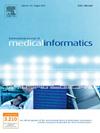Hip prosthesis failure prediction through radiological deep sequence learning
IF 3.7
2区 医学
Q2 COMPUTER SCIENCE, INFORMATION SYSTEMS
International Journal of Medical Informatics
Pub Date : 2025-01-22
DOI:10.1016/j.ijmedinf.2025.105802
引用次数: 0
Abstract
Background
Existing deep learning studies for the automated detection of hip prosthesis failure only consider the last available radiographic image. However, using longitudinal data is thought to improve the prediction, by combining temporal and spatial components. The aim of this study is to develop artificial intelligence models for predicting hip implant failure from multiple subsequent plain radiographs.
Methods
A cohort of 224 patients was considered for model development and a balanced cohort of 14 patients was used for external validation. A sequence of two or three anteroposterior radiographic images per patient was considered to track the prosthesis over time. A combination of a convolutional neural network (CNN) and a recurrent section was used. For the CNN, a pretrained autoencoder, a pretrained RadImageNet DenseNet and a pretrained custom DenseNet were considered. The recurrent section was implemented using either a single Gated Recurrent Unit (GRU) layer or a Long Short-Term Memory block.
Results
Considering 3 images as input provided a positive predictive value (PPV) of 0.966 and an f1 score of 0.933 on the validation set. Regarding the 2-image models, using the postoperative and the last image resulted in PPV of 0.933 and f1 score of 0.918, whereas using the second-to-last image with the post-operative one reached a PPV of 0.882 and f1 score of 0.923. On the external validation set, the 3-image model reached an accuracy of 0.786.
Conclusion
This study demonstrated the potential of the developed models, based on a series of plain radiographs, to predict hip prosthesis failure.
求助全文
约1分钟内获得全文
求助全文
来源期刊

International Journal of Medical Informatics
医学-计算机:信息系统
CiteScore
8.90
自引率
4.10%
发文量
217
审稿时长
42 days
期刊介绍:
International Journal of Medical Informatics provides an international medium for dissemination of original results and interpretative reviews concerning the field of medical informatics. The Journal emphasizes the evaluation of systems in healthcare settings.
The scope of journal covers:
Information systems, including national or international registration systems, hospital information systems, departmental and/or physician''s office systems, document handling systems, electronic medical record systems, standardization, systems integration etc.;
Computer-aided medical decision support systems using heuristic, algorithmic and/or statistical methods as exemplified in decision theory, protocol development, artificial intelligence, etc.
Educational computer based programs pertaining to medical informatics or medicine in general;
Organizational, economic, social, clinical impact, ethical and cost-benefit aspects of IT applications in health care.
 求助内容:
求助内容: 应助结果提醒方式:
应助结果提醒方式:


